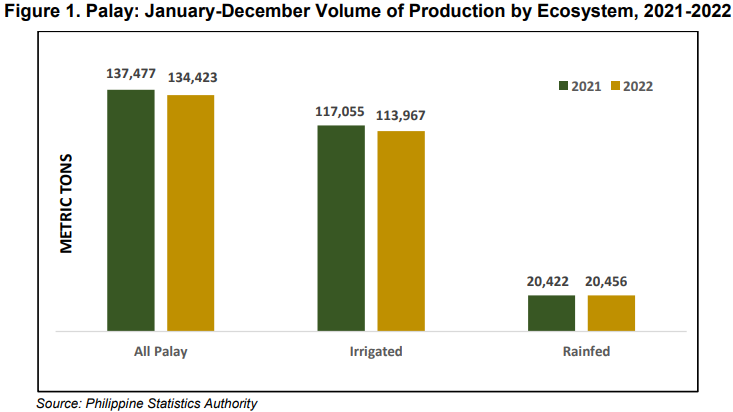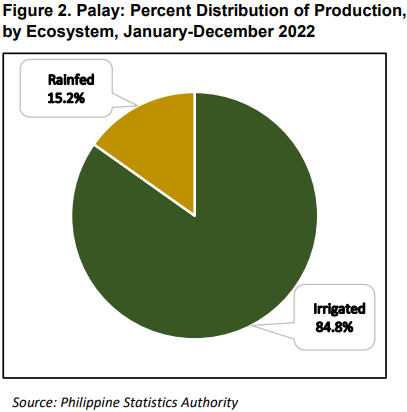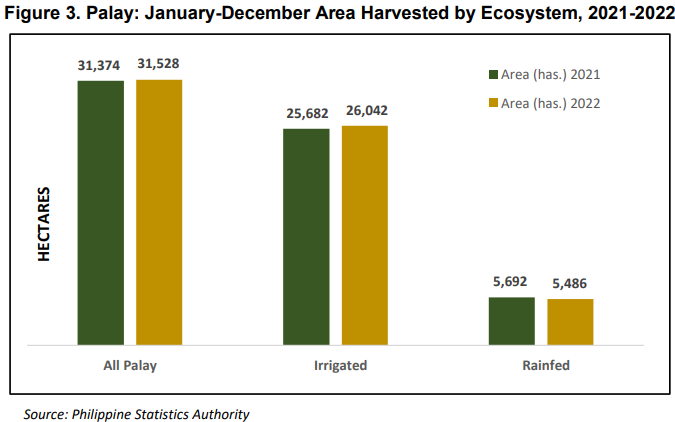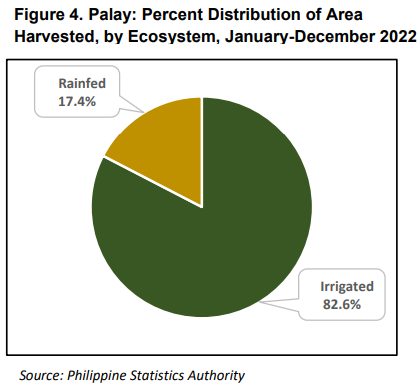Palay: Volume of production decreases by -2.2 percent
The total palay production in Davao de Oro for January-December 2022, estimated at 134,423 metric tons, was lower than the 137,477 metric tons production in 2021. This is a slight decrease of -2.2 percent or an equivalent of 3,054 metric tons of palay production, from the previous year’s level. The negative growth was attributed mainly to the effect of flooding during the first quarter of 2022 in some low-lying palay areas as caused by the presence of Low Pressure Areas (LPA) in Mindanao. (Figure 1)


By type of ecosystem, production of irrigated palay was estimated at 113,967 metric tons, a decrease of -2.6 percent as compared to last year’s production of 117,055 metric tons. Rainfed palay production, on the other hand, posted an increase of 0.2 percent with a production of 20,456 metric tons as compared to 20,422 metric tons production in 2021. Of the total palay production, 84.8 percent was irrigated palay while 15.2 percent was rainfed palay. (Figure 2)
Palay: Area harvested increased by 0.5 percent
The total estimated area harvested of palay in Davao de Oro for January-December 2022 increased by 0.5 percent from 31,374 hectares in 2021 to 31,528 hectares in 2022. The increase was attributed mainly to the movement of cropping pattern observed in the province.(Figure 3)


By type of ecosystem, total area plantings of irrigated palay posted a slight increase of 1.4 percent as compared in 2021, from 25,682 hectares to 26,042 hectares in 2022. On the other hand, rainfed palay decreased by -3.6 percent with a total area of 5,486 hectares in 2022 from 5,692 in 2021. Of the total area harvested, 82.6 percent were irrigated palay while 17.4 percent were rainfed. (Figure 4)
Palay: Yield per hectare drops by -2.7 percent
The yield of palay per hectare in Davao de Oro decreased by -2.7 percent for 2022, from 2021 record of 4.38 metric tons per hectare down to 4.26 metric tons per hectare in 2022. The decrease in yield was attributed to some palay areas in the province being affected by floods in the first quarter. (Figure 5)

By type of ecosystem, the yield of irrigated palay posted a decrease of -4.0 percent from 4.56 metric tons per hectare in 2021 down to 4.38 metric tons per hectare in 2022. Meanwhile, the yield of rainfed palay increased by 0.3 percent from 3.77 metric tons in 2021 to 3.78 metric tons in 2022.
Statistical Table

Technical Notes:
Palay Production Survey (PPS) is one of the major agricultural surveys conducted by the Philippine Statistics Authority (PSA). This generates estimates and forecasts on palay production, area and yield, and other production-related data that serve as inputs for policy-making and programs on palay/rice.
This is a quarterly survey that covers sample farming households in sample barangays in all provinces except Batanes. Data item gathered on this survey includes production, area planted/harvested, and yield by ecosystem; usage of seeds, fertilizer and pesticides, source of irrigation water and adequacy, monthly distribution of production and area harvested, farm household disposition of production and area with standing crops.
Production refers to the quantity produced and actually harvested for the particular crop during the reference period. For palay, harvest area refers to the actual area harvested during the reference quarter.
Area harvested refers to the actual area from which harvests are realized.
Yield is an indicator of productivity derived by dividing total production by the area harvested.
